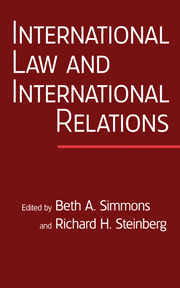Book contents
- Frontmatter
- Contents
- Contributors
- Abstracts
- Preface
- Editors' Note
- PART I INTERNATIONAL REGIMES THEORY: DOES LAW MATTER?
- PART II COMMITMENT AND COMPLIANCE
- PART III LEGALIZATION AND ITS LIMITS
- 6 The Concept of Legalization (2000)
- 7 Legalized Dispute Resolution: Interstate and Transnational (2000)
- 8 Legalization, Trade Liberalization, and Domestic Politics: A Cautionary Note (2000)
- 9 Alternatives to “Legalization”: Richer Views of Law and Politics (2001)
- PART IV INTERNATIONAL LAW AND INTERNATIONAL NORMS
- PART V TREATY DESIGN AND DYNAMICS
- PART VI LAW AND LEGAL INSTITUTIONS
- PART VII OTHER SUBSTANTIVE AREAS OF INTERNATIONAL LAW
- References
- Index
7 - Legalized Dispute Resolution: Interstate and Transnational (2000)
Published online by Cambridge University Press: 05 June 2012
- Frontmatter
- Contents
- Contributors
- Abstracts
- Preface
- Editors' Note
- PART I INTERNATIONAL REGIMES THEORY: DOES LAW MATTER?
- PART II COMMITMENT AND COMPLIANCE
- PART III LEGALIZATION AND ITS LIMITS
- 6 The Concept of Legalization (2000)
- 7 Legalized Dispute Resolution: Interstate and Transnational (2000)
- 8 Legalization, Trade Liberalization, and Domestic Politics: A Cautionary Note (2000)
- 9 Alternatives to “Legalization”: Richer Views of Law and Politics (2001)
- PART IV INTERNATIONAL LAW AND INTERNATIONAL NORMS
- PART V TREATY DESIGN AND DYNAMICS
- PART VI LAW AND LEGAL INSTITUTIONS
- PART VII OTHER SUBSTANTIVE AREAS OF INTERNATIONAL LAW
- References
- Index
Summary
International courts and tribunals are flourishing. Depending on how these bodies are defined, they now number between seventeen and forty. In recent years we have witnessed the proliferation of new bodies and a strengthening of those that already exist. “When future international legal scholars look back at … the end of the twentieth century,” one analyst has written, “they probably will refer to the enormous expansion of the international judiciary as the single most important development of the post–Cold War age.”
These courts and tribunals represent a key dimension of legalization. Instead of resolving disputes through institutionalized bargaining, states choose to delegate the task to third-party tribunals charged with applying general legal principles. Not all of these tribunals are created alike, however. In particular, we distinguish between two ideal types of international dispute resolution: interstate and transnational. Our central argument is that the formal legal differences between interstate and transnational dispute resolution have significant implications for the politics of dispute settlement and therefore for the effects of legalization in world politics.
Interstate dispute resolution is consistent with the view that public international law comprises a set of rules and practices governing interstate relationships. Legal resolution of disputes, in this model, takes place between states conceived of as unitary actors.
- Type
- Chapter
- Information
- International Law and International RelationsAn International Organization Reader, pp. 131 - 156Publisher: Cambridge University PressPrint publication year: 2007



